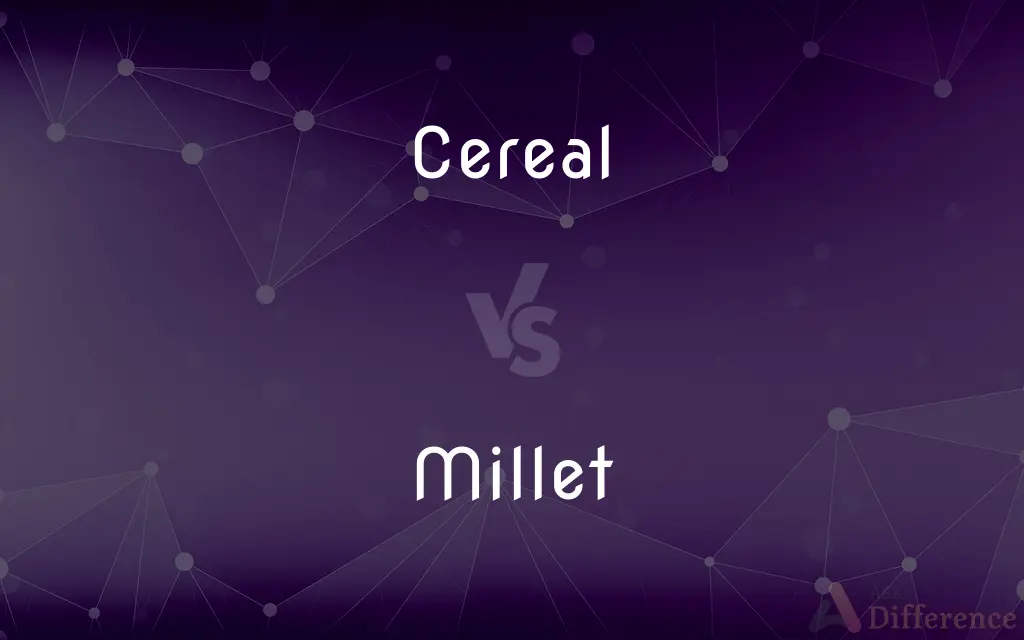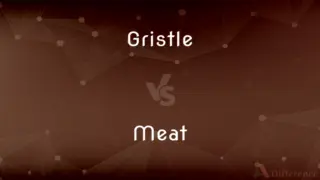Cereal vs. Millet — What's the Difference?
By Fiza Rafique & Urooj Arif — Updated on May 15, 2024
Cereal grains are grasses cultivated for their edible starchy seeds, including wheat, rice, and corn, while millets are a group of small-seeded grains, often grown in arid climates and less refined.

Difference Between Cereal and Millet
Table of Contents
ADVERTISEMENT
Key Differences
Cereals are primarily the seeds of cultivated grasses and form a staple food in various diets globally, providing carbohydrates, proteins, and vitamins. While millets, a less common group of cereals, are also grasses but are characterized by their ability to thrive in harsh environments and poorer soils.
Millets are regarded for their nutritional benefits, including being gluten-free and high in fiber and antioxidants, whereas cereals like wheat and barley contain gluten, making them unsuitable for those with gluten intolerances.
While cereals are often processed into refined products such as bread, pasta, and cereal flakes, millets are usually consumed in their whole form, preserving more of their nutrients and providing health benefits like improved digestion and reduced risk of diabetes.
In terms of cultivation, cereals are extensively farmed around the world, enjoying global prominence and substantial research and development for yield improvement. On the other hand, millets are often grown in regions with less agricultural investment and are sometimes considered "orphan crops" despite their nutritional and ecological benefits.
Regarding culinary uses, cereals are versatile and used in a wide array of dishes from breakfast cereals to desserts. Millets, although less versatile, are gaining popularity in health-conscious and gluten-free recipes.
ADVERTISEMENT
Comparison Chart
Type
Grasses
Grasses
Gluten Content
Often contains gluten
Gluten-free
Nutritional Benefits
High in carbohydrates
High in fiber, antioxidants
Common Uses
Bread, pasta, breakfast foods
Traditional dishes, gluten-free foods
Cultivation
Widely cultivated globally
Grown in arid, less fertile regions
Compare with Definitions
Cereal
A grass cultivated for the edible components of its grain.
Rice is a popular cereal in Asia.
Millet
Often used in birdseed mixtures.
The birdseed was mostly composed of millet.
Cereal
Any foodstuff made from processed cereal grains.
Cereal is a common breakfast choice.
Millet
Used as fodder as well as human consumption.
The farmer grew millet primarily for cattle feed.
Cereal
In broader terms, any grain-like crops cultivated for similar uses.
Sorghum is considered a cereal in many countries.
Millet
The small round grains of the millet plant.
Millet can be cooked similar to rice.
Cereal
Relating to cereal plants or grains.
Cereal production requires large, fertile fields.
Millet
Small-seeded grasses widely grown around the world as cereal crops.
Millet thrives in the arid parts of Africa.
Cereal
A cereal is any grass cultivated (grown) for the edible components of its grain (botanically, a type of fruit called a caryopsis), composed of the endosperm, germ, and bran. The term may also refer to the resulting grain itself (specifically "cereal grain").
Millet
Known for its rapid growth and harvest potential.
Millet is ready for harvest much quicker than many other grains.
Cereal
A grass such as wheat, oats, or corn, the starchy grains of which are used as food.
Millet
Millets () are a group of highly variable small-seeded grasses, widely grown around the world as cereal crops or grains for fodder and human food. Millets are important crops in the semiarid tropics of Asia and Africa (especially in India, Mali, Nigeria, and Niger), with 97% of millet production in developing countries.
Cereal
The grain of such a grass.
Millet
A cereal grown in warm countries and regions with poor soils, bearing a large crop of small seeds which are chiefly used to make flour.
Cereal
Any of several other plants or their edible seeds or fruit, such as buckwheat or certain species of amaranth.
Millet
Any of various annual grasses with small grains that are harvested for food, livestock feed, and birdseed, especially proso millet.
Cereal
A food prepared from any of these plants, especially a breakfast food made from commercially processed grain.
Millet
The grains of any of these plants.
Cereal
Consisting of or relating to grain or to a plant producing grain.
Millet
A demographic group in the Ottoman Empire, defined in terms of religious affiliation and enjoying a degree of legal autonomy.
Cereal
(countable) A type of grass (such as wheat, rice or oats) cultivated for its edible grains.
Millet
Any of a group of various types of grass or its grains used as food, widely cultivated in the developing world.
Cereal
(uncountable) The grains of such a grass.
Millet
(specifically) common millet, in particular Panicum miliaceum.
Cereal
(uncountable) Breakfast cereal.
Would you like some cereal?
Which cereal would you like for breakfast?
A bowl of cereal
Millet
(historical) A semi-autonomous confessional community under the Ottoman Empire, especially a non-Muslim one.
Cereal
Of or pertaining to the grasses which are cultivated for their edible seeds (as wheat, maize, rice, etc.), or to their seeds or grain.
Millet
The name of several cereal and forage grasses which bear an abundance of small roundish grains. The common millets of Germany and Southern Europe are Panicum miliaceum, and Setaria Italica.
Cereal
Any grass cultivated for its edible grain, or the grain itself; - usually in the plural.
Millet
Any of various small-grained annual cereal and forage grasses of the genera Panicum, Echinochloa, Setaria, Sorghum, and Eleusine
Cereal
Grass whose starchy grains are used as food: wheat; rice; rye; oats; maize; buckwheat; millet
Millet
French painter of rural scenes (1814-1875)
Cereal
Foodstuff prepared from the starchy grains of cereal grasses
Millet
Small seed of any of various annual cereal grasses especially Setaria italica
Cereal
A breakfast food prepared from grain
Cereal
Made of grain or relating to grain or the plants that produce it;
A cereal beverage
Cereal grasses
Cereal
The edible grain produced by the cereal plant.
The cereal was ground into flour for baking.
Common Curiosities
What is millet?
Millet refers to small-seeded grains of several species of cereal grasses.
What are cereals?
Cereals are grains obtained from cultivated grasses used for food.
Can millets be used in gluten-free diets?
Yes, millets are suitable for gluten-free diets due to their lack of gluten.
Which is more widely cultivated, cereals or millets?
Cereals are more widely cultivated globally compared to millets.
What are common uses of cereals?
Cereals are commonly used in making bread, pasta, and breakfast cereals.
Are cereals nutritious?
Cereals are nutritious, providing essential carbohydrates and proteins.
How do cereals and millets differ in gluten content?
Cereals often contain gluten, while millets are naturally gluten-free.
What are the health benefits of millet?
Millet offers high fiber, aids digestion, and can help manage blood sugar levels.
What are the environmental benefits of growing millet?
Millet requires less water and can grow in poorer soil, making it environmentally friendly.
Why are millets considered good for harsh climates?
Millets can thrive in arid conditions where other crops may fail.
Can cereals be part of a gluten-free diet?
Not all cereals, as many contain gluten; however, options like corn are gluten-free.
Share Your Discovery

Previous Comparison
Gristle vs. Meat
Next Comparison
Us vs. OurselvesAuthor Spotlight
Written by
Fiza RafiqueFiza Rafique is a skilled content writer at AskDifference.com, where she meticulously refines and enhances written pieces. Drawing from her vast editorial expertise, Fiza ensures clarity, accuracy, and precision in every article. Passionate about language, she continually seeks to elevate the quality of content for readers worldwide.
Co-written by
Urooj ArifUrooj is a skilled content writer at Ask Difference, known for her exceptional ability to simplify complex topics into engaging and informative content. With a passion for research and a flair for clear, concise writing, she consistently delivers articles that resonate with our diverse audience.
















































